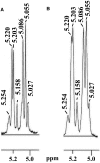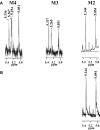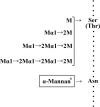Presence of O-glycosidically linked oligosaccharides in the cell wall mannan of Candida krusei purified with Benanomicin A
- PMID: 30652080
- PMCID: PMC6325602
- DOI: 10.1002/2211-5463.12558
Presence of O-glycosidically linked oligosaccharides in the cell wall mannan of Candida krusei purified with Benanomicin A
Abstract
Cell wall mannan of the pathogenic yeast Candida krusei was prepared using the antibiotic Benanomicin A, which has a lectin-like function. The chemical structure of this molecule was found to be similar to that of mannan prepared from the same yeast by the conventional method using Fehling reagent. Only a few degradation products were detected when the mannan prepared using Fehling reagent was subjected to alkali treatment (β-elimination), but multiple α-1,2-linked oligosaccharides were detected when the mannan purified with Benanomicin A was treated with alkali. These results indicate that most of the O-linked sugar chains in mannan were lost under conventional conditions when exposed to the strongly alkaline Fehling reagent. In contrast, the O-glycosidic bond in mannan was not cleaved and the O-linked sugar chains were maintained and almost intact following treatment with the mild novel preparation method using Benanomicin A. Therefore, we argue that the new mannan preparation method using Benanomicin A is superior to conventional methods. In addition, our study suggests that some yeast mannans, whose overall structure has already been reported, may contain more O-linked sugar chains than previously recognized.
Keywords: Benanomicin A; Candida krusei; O‐linked sugar; antibiotic; cell wall mannan; β‐elimination.
Figures






Similar articles
-
Existence of branched side chains in the cell wall mannan of pathogenic yeast, Candida albicans. Structure-antigenicity relationship between the cell wall mannans of Candida albicans and Candida parapsilosis.J Biol Chem. 1995 Jan 20;270(3):1113-22. doi: 10.1074/jbc.270.3.1113. J Biol Chem. 1995. PMID: 7836369
-
Structural study of a cell wall mannan-protein complex of the pathogenic yeast Candida glabrata IFO 0622 strain.Arch Biochem Biophys. 1992 May 1;294(2):662-9. doi: 10.1016/0003-9861(92)90739-j. Arch Biochem Biophys. 1992. PMID: 1567221
-
Structure of cell wall mannan of Candida kefyr IFO 0586.Infect Immun. 1994 Oct;62(10):4425-31. doi: 10.1128/iai.62.10.4425-4431.1994. Infect Immun. 1994. PMID: 7927705 Free PMC article.
-
Immunochemistry of pathogenic yeast, Candida species, focusing on mannan.Proc Jpn Acad Ser B Phys Biol Sci. 2012;88(6):250-65. doi: 10.2183/pjab.88.250. Proc Jpn Acad Ser B Phys Biol Sci. 2012. PMID: 22728440 Free PMC article. Review.
-
[Structure of fungal cell wall polysaccharides].Nihon Ishinkin Gakkai Zasshi. 2006;47(3):179-84. doi: 10.3314/jjmm.47.179. Nihon Ishinkin Gakkai Zasshi. 2006. PMID: 16940952 Review. Japanese.
Cited by
-
Current Aspects in the Biology, Pathogeny, and Treatment of Candida krusei, a Neglected Fungal Pathogen.Infect Drug Resist. 2020 Jun 10;13:1673-1689. doi: 10.2147/IDR.S247944. eCollection 2020. Infect Drug Resist. 2020. PMID: 32606818 Free PMC article. Review.
References
-
- Hegazi M, Abdelkader A, Zaki M and EI‐Deek B (2014) Characteristics and risk factors of candidemia in pediatric intensive care unit of a tertiary care children's hospital in Egypt. J Infect Dev Ctries 8, 624–634. - PubMed
-
- Kakeya H, Yamada K, Kaneko Y, Yanagihara K, Tateda K, Maesaki S, Takesue Y, Tomono K, Kadota JI, Kaku M et al (2018) National trends in the distribution of Candida species causing Candidemia in Japan from 2003 to 2014. Med Mycol J 59, E19–E22. - PubMed
-
- Johnson LB and Kauffman CA (2003) Voriconazole: a new triazole antifungal agent. Clin Infect Dis 36, 630–637. - PubMed
-
- Pfaller MA, Moet GJ, Messer SA, Jones RN and Castanheira M (2011) Geographic variations in species distribution and echinocandin and azole antifungal resistance rates among Candida bloodstream infection isolates: report from the SENTRY Antimicrobial Surveillance Program (2008 to 2009). J Clin Microbiol 49, 396–399. - PMC - PubMed
MeSH terms
Substances
LinkOut - more resources
Full Text Sources

